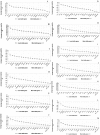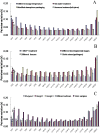Evaluation of new reference genes in papaya for accurate transcript normalization under different experimental conditions
- PMID: 22952972
- PMCID: PMC3432124
- DOI: 10.1371/journal.pone.0044405
Evaluation of new reference genes in papaya for accurate transcript normalization under different experimental conditions
Abstract
Real-time reverse transcription PCR (RT-qPCR) is a preferred method for rapid and accurate quantification of gene expression studies. Appropriate application of RT-qPCR requires accurate normalization though the use of reference genes. As no single reference gene is universally suitable for all experiments, thus reference gene(s) validation under different experimental conditions is crucial for RT-qPCR analysis. To date, only a few studies on reference genes have been done in other plants but none in papaya. In the present work, we selected 21 candidate reference genes, and evaluated their expression stability in 246 papaya fruit samples using three algorithms, geNorm, NormFinder and RefFinder. The samples consisted of 13 sets collected under different experimental conditions, including various tissues, different storage temperatures, different cultivars, developmental stages, postharvest ripening, modified atmosphere packaging, 1-methylcyclopropene (1-MCP) treatment, hot water treatment, biotic stress and hormone treatment. Our results demonstrated that expression stability varied greatly between reference genes and that different suitable reference gene(s) or combination of reference genes for normalization should be validated according to the experimental conditions. In general, the internal reference genes EIF (Eukaryotic initiation factor 4A), TBP1 (TATA binding protein 1) and TBP2 (TATA binding protein 2) genes had a good performance under most experimental conditions, whereas the most widely present used reference genes, ACTIN (Actin 2), 18S rRNA (18S ribosomal RNA) and GAPDH (Glyceraldehyde-3-phosphate dehydrogenase) were not suitable in many experimental conditions. In addition, two commonly used programs, geNorm and Normfinder, were proved sufficient for the validation. This work provides the first systematic analysis for the selection of superior reference genes for accurate transcript normalization in papaya under different experimental conditions.
Conflict of interest statement
Figures





Similar articles
-
Validation of reference genes for RT-qPCR studies of gene expression in banana fruit under different experimental conditions.Planta. 2011 Aug;234(2):377-90. doi: 10.1007/s00425-011-1410-3. Epub 2011 Apr 20. Planta. 2011. PMID: 21505864
-
Identification and evaluation of new reference genes in Gossypium hirsutum for accurate normalization of real-time quantitative RT-PCR data.BMC Plant Biol. 2010 Mar 21;10:49. doi: 10.1186/1471-2229-10-49. BMC Plant Biol. 2010. PMID: 20302670 Free PMC article.
-
Validation of reference genes as internal control for studying viral infections in cereals by quantitative real-time RT-PCR.BMC Plant Biol. 2010 Jul 15;10:146. doi: 10.1186/1471-2229-10-146. BMC Plant Biol. 2010. PMID: 20630112 Free PMC article.
-
A systematic review on the selection of reference genes for gene expression studies in rodents: are the classics the best choice?Mol Biol Rep. 2024 Sep 26;51(1):1017. doi: 10.1007/s11033-024-09950-3. Mol Biol Rep. 2024. PMID: 39327364
-
Advancements in Reference Gene Selection for Fruit Trees: A Comprehensive Review.Int J Mol Sci. 2024 Jan 17;25(2):1142. doi: 10.3390/ijms25021142. Int J Mol Sci. 2024. PMID: 38256212 Free PMC article. Review.
Cited by
-
Assessment of Suitable Reference Genes for Quantitative Gene Expression Studies in Melon Fruits.Front Plant Sci. 2016 Aug 3;7:1178. doi: 10.3389/fpls.2016.01178. eCollection 2016. Front Plant Sci. 2016. PMID: 27536316 Free PMC article.
-
The effect of immunological status, in-vitro treatment and culture time on expression of eleven candidate reference genes in bovine blood mononuclear cells.BMC Immunol. 2015 May 30;16:33. doi: 10.1186/s12865-015-0099-7. BMC Immunol. 2015. PMID: 26025301 Free PMC article.
-
Screening and Validation of Housekeeping Genes of the Root and Cotyledon of Cunninghamia lanceolata under Abiotic Stresses by Using Quantitative Real-Time PCR.Int J Mol Sci. 2016 Jul 28;17(8):1198. doi: 10.3390/ijms17081198. Int J Mol Sci. 2016. PMID: 27483238 Free PMC article.
-
Selection of appropriate reference genes for quantitative real-time reverse transcription PCR in Betula platyphylla under salt and osmotic stress conditions.PLoS One. 2019 Dec 3;14(12):e0225926. doi: 10.1371/journal.pone.0225926. eCollection 2019. PLoS One. 2019. PMID: 31794584 Free PMC article.
-
Identification of suitable reference genes for gene expression normalization in qRT-PCR analysis in watermelon.PLoS One. 2014 Feb 28;9(2):e90612. doi: 10.1371/journal.pone.0090612. eCollection 2014. PLoS One. 2014. PMID: 24587403 Free PMC article.
References
-
- Bustin SA (2002) Quantification of mRNA using real-time reverse transcription PCR (RT-PCR): trends and problems. Journal of Molecular Endocrinology 29: 23. - PubMed
-
- Reece RJ (2004) Analysis of Genes and Genomes: NJ.
-
- Ginzinger DG (2002) Gene quantification using real-time quantitative PCR: An emerging technology hits the mainstream. Experimental Hematology 30: 503–512. - PubMed
-
- Huggett J, Dheda K, Bustin S, Zumla A (2005) Real-time RT-PCR normalisation; strategies and considerations. Genes Immun 6: 279–284. - PubMed
Publication types
MeSH terms
Substances
LinkOut - more resources
Full Text Sources
Research Materials
Miscellaneous

